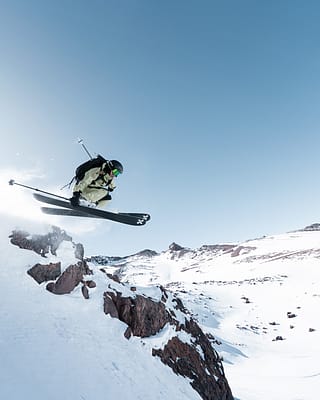Ski tips for intermediate skiers
Is your riding plateauing? Hunting for some insider tips to help dial in your skiing? This is the article for you.

There’s a lot to master when it comes to skiing. And if you’ve progressed from snowplough to parallel turns, you might now wonder where to go next. If this is the case, there’s a good chance you’ve stalled at that intermediate plateau.
It’s totally normal and happens to almost all skiers! However, taking more lessons doesn’t seem 100% necessary, so what’s the next step? We’ve rounded up the best tips from instructors, videos, and our own experience and put them in this handy guide.
And if you’re ready to step up your style game, why not check out our range of the slickest ski jackets and ski pants on the mountain?
Quick find navigation
Common mistakes intermediate skiers make
Perfect your body positioning
Focus on your conditioning
Nail your technique
Work with the snow
Challenge yourself
Other tips and advice
Common mistakes intermediate skiers make
When you’re learning to ski, it’s easy to bed in bad technique and limit your future progression. You may not think the things you do one day might affect you seasons later, but you’d be surprised.
This is especially true with body positioning, tension, and, of course, technique. So, let’s think about some things that might hold you back before we start on the things you should be doing.
There’s a chance you’re standing too upright and leaning back too much on your skis. This is definitely a ‘comfortable’ position and will be fine at slow speeds and on shallow grades. However, as you progress to faster and steeper riding, this body position will put lots of pressure on the tail of the skis and prevent you from easily initiating turns. If this is the case, you’re likely just in the wrong position.
If you’re struggling to get on edge and initiate a carve, it’s probably a technique and body movement issue. However, despite these two things being the largest challenges facing many intermediate riders, they’re easy to solve. So, let’s begin with positioning, because that’s the root of most problems.

Perfect your body positioning
There is no ‘perfect’ body position for skiing as every spot on the mountain is different and will require an adaptive approach to riding. But let’s talk about the ‘neutral’ riding position. It’s a commonality for all sports. In mountain biking, it’s that stance just up off the seat, weight centered, knees bent, heels down, elbows out. In snowboarding, it’s your weight shifted slightly forward, shoulders back and parallel to the board, knees bent, pelvis neutral, chin on shoulder.
And skiing is no different. First, have your shins against the front of your boots and your weight over your toes. As your bindings are centered on the skis at the waist (the center of the sidecut), that's where you need to be initiating your turns. Your weight shifted forward will allow the tips of the skis to go where your knees point, find the snow, and dig that edge in for proper turn initiation.
Slightly bend your knees to absorb bumps and chatter, and part them, so it’s comfortable to get into a squat position. Place your body in a slightly bent position with your hands hanging just in front of your hips. Shoulders should not be slumped, and your chin should be up, eyes pointed to a spot 10-30ft in front of you, depending on how fast you’re riding and how many moguls you need to dodge.
This is the best starting position and is a really responsive place to ride from. Get this position nailed, and you’re in good stead to tackle whatever the mountain throws at you.

Focus on your conditioning
Unfortunately, many of us do nothing to improve our conditioning throughout the year. Then, we turn up on a ski trip and expect to hold a squat for five hours a day, six days in a row.
Now, some lucky ones might pull this off. But for most of us mortals, our legs will be jelly by midday on day one. So, if there’s one tip you should absolutely take on board, train on the lead-up to your next trip!
Holding the correct body position all day is imperative for improving your skills. If you stand tall to give yourself a rest, then not only are you not practicing the correct body positioning, but you’re also bedding in that fault.
The more time you spend in the wrong position, the more natural it will feel, and the more unnatural the right position will feel. So, practice those ski-sits and squats before heading to the mountains!

Nail your technique
Following on naturally from the above, you’ll find yourself unable to execute the correct techniques when you need to. As you improve your riding, stretching for higher speeds, deeper carves, and tackling more challenging terrain, you’ll need to really hone your technique to stay safe and in control on the snow.
The big one here is turning. If you’re going straight or in between turns, you’re either returning to your neutral riding position or speed tucking. There’s not a lot to figure out until you hunt some air. So the technique really becomes essential in your turn initiation, execution, and exit.
I’ve had it described to me in two ways: imagine yourself as either the pendulum in a clock or as a bellows (like a blacksmith uses). The idea is to get into a rhythm. You bob down into your turns, leaning forward and in, pressing your edges to the snow, then transferring back to a flat base before turning the other way to link your carves.
You’ll need to hit that comfortable neutral position between those turns to be in the right place to initiate the next. Having this ‘up and down’ movement mimics how a bellows moves, and the side-to-side isn’t dissimilar to a pendulum swinging. If you can develop a solid rhythm, moving through the correct neutral position each time, then you’ll find your skills improve pretty quickly.

Work with the snow
Working with the snow (and not against it) is a big part of any skier’s progression. Looking ahead and competently reading the snow in front of you will allow you to be much more adaptable as you ride.
Sometimes you’ll need to think quickly and react, too. Having this skill in your bag will be indispensable as you ride faster.
When working with the snow, think about the conditions you’re riding. Hardpack, groomed snow, slush, slough, powder – whatever it is, dig your edges in accordingly and transfer your weight in anticipation of how hard the mountain will push back. In powder, you’ll want more weight over your heels. On hardpack and the groomers, really sink those edges in, leading with your weight forward.
The way your body moves will be imperative, too. Depending on the gradient and traction, you may need quick, sharp turns to navigate obstacles and moguls. If it’s a wide powder field or open run, longer, smoother turns are likely to be the best choice. So, work with what the mountain is offering, not against it, and your skills will widen and improve.

Challenge yourself
Pushing yourself past your point of comfort is the best way to progress your riding. Many plateau because they keep riding terrain they’re comfortable with in a way they’re comfortable with. You’ll become better by riding unfamiliar terrain or pushing your riding on familiar terrain.
Advanced riders do two things — they ride with speed and confidence. So riding new terrain will help increase your adaptability and confidence, while riding familiar terrain harder will help improve your speed.
Use the three-second rule if you’re struggling to break old habits. When you get to that moment where you feel you’re going too fast and want to hit the brakes, count backwards from three in your head. Then brake.
This will help you push your boundaries and increase your fear thresholds. Both are common roadblocks for those trying to push their riding.

Other tips and advice
There are other things you can do to help progress your riding. The first is getting better or more specialized gear.
If you’re using generic, older, or rental gear, your riding may be limited. However, using high-quality equipment that’s the correct fit and style (i.e., powder skis for riding in powder and boots that are good quality and properly fitted) will significantly impact your riding.
Learning more about your gear’s technical limitations and attributes is essential for understanding the mechanics of what’s going on under your feet on the mountain. So make sure you’re working with the right tools for the job.
The other option is simple: take a lesson. As an intermediate rider, taking more lessons may not seem extremely useful. But a one-on-one session with a highly skilled teacher is a great way to improve your riding fast. They’ll be able to help break you out of bad habits, as well as give you in-the-moment feedback as you ride.

Wrapping up
Well, that’s all our top tips for intermediate riders looking to improve. The biggest thing we want to leave you with is that there is no replacement for time on the snow.
No matter how much reading, watching, or research you do, the most surefire way to progress as a skier – and break out of that intermediate slump — is to get out there and keep pushing yourself. The more you ride, the better you’ll get.
See you on the slopes!
Related reading:
